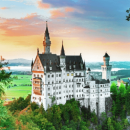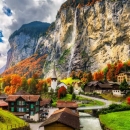
Chase adventure in Switzerland by train: Interlaken to Jungfrau region
Rumoured to be home to the world's longest sled run, there's no shortage of thrills in the Jungfrau region
10 January 2024
In a place as vast and rugged as Switzerland’s Jungfrau region, it seems only fitting that some mysteries remain unsolved.
That’s the thought that flashed through my mind as I sat, perched on a toboggan, about to attempt what’s rumoured to be the longest sledge run in the world.
I squinted in the winter sunlight, surveying the snow-capped peaks of the Bernese Alps. Butterflies dancing in the pit of my stomach, I kicked off the ground, beginning the descent before I could lose my nerve.
So began my journey down Big Pintenfritz, a 15-kilometre sledge run that begins 2,500 metres above sea level.
Swerving and shrieking my way down the run, I felt equal parts elation and terror – the sort of thrill that most of us leave behind in childhood. As I used my feet to brake, snow ricocheting in every direction, I felt thankful for the chance to experience this sort of gleeful exhilaration once again.
Catapulting down Big Pintenfritz, little did I know I was participating in a longstanding tradition of locals and tourists alike, dating back for over a century.
I later learned the Big Pintenfritz sledge run is named after Fritz Bohren, nicknamed "Pintenfritz", a local celebrity and owner of the Faulhorn hotel from 1888 to 1926. Legend has it, Bohren would sledge all the way down to Grindelwald after a day’s work to see friends and stay overnight in town.
To this day, no one knows how Bohren would return to work at the Faulhorn hotel by the early morning – after all, there was no railway connecting the hotel to Grindelwald’s town centre below. Even today, sledgers can only reach the start of Big Pintenfritz by hiking through the snow for two hours, from the gondola station at Grindelwald First’s peak, past Lake Bachalpsee, all the way to Faulhorn.
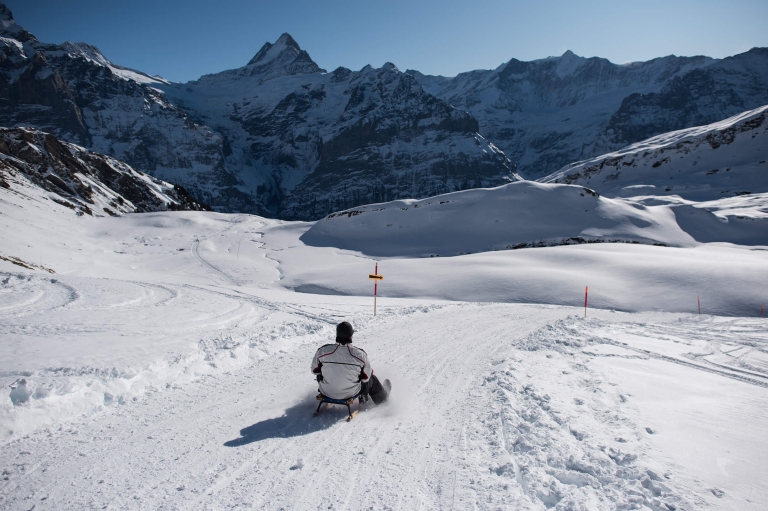
This puzzle is something to ponder as you journey from Interlaken into the Jungfrau region on the Berner Oberland Bahn, recently included in the Interrail Pass Network. As of December, travellers with the Pass can ride reservation-free from Interlaken to Grindelwald and Lauterbrunnen, among other towns in the area.
Since that first sledging trip in 2022, I have returned to the Jungfrau region four separate times, in every season, falling a little more in love with each visit.
This land is wild, brutal and beautiful at the same time. A place for daring climbers and determined farmers, hardworking hotel employees and tireless ski resort workers. An inspiration for famous writers and artists and a haven for families enjoying a ski holiday together.
Each adventure begins long before hitting the ski slopes or lacing on a pair of hiking boots – rather, I always feel an adrenaline rush when boarding the Berner Oberland Bahn at Interlaken Ost.
In addition to careening down the world’s longest sledge run, here are a few of my favourite experiences – so far – in the Jungfrau region, and the rail journeys I took along the way. Experience them all with an Interrail Global Pass.
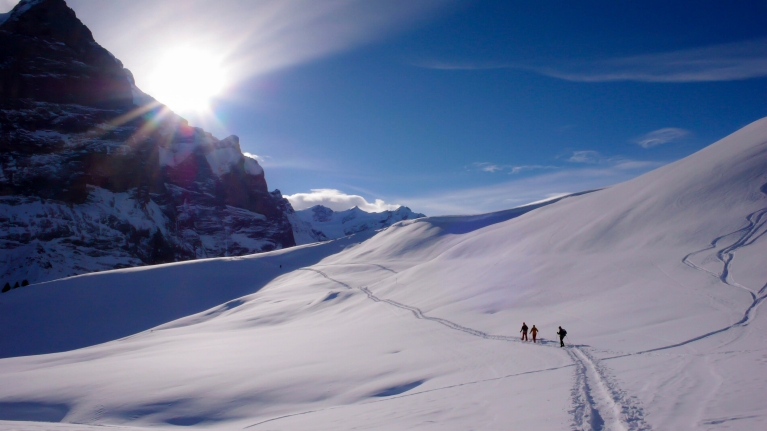
Snowshoeing in the shadow of the Eiger
The Berner Oberland Bahn’s canary yellow and cobalt train cars whisk travellers and locals from Interlaken Ost along the rushing Lütschine river through thick forest. The train splits in half at Zweilütschinen, one half carrying on to Grindelwald, the other to Lauterbrunnen.
With multiple gondola routes into the mountains, Grindelwald is a convenient home base for hikers and winter sports enthusiasts. Some may take the gondola up to the slopes off Grindelwald First, while others board the ultra-modern Eiger Express.
One dazzlingly sunny morning – the day after my Big Pintenfritz sledging adventure – I boarded the massive, 26-seat Eiger Express alongside skiers and snowboarders, ready to begin a morning of snowshoeing.
Nothing could have prepared me for the awe I’d feel as the cable car approached the imposing Eiger mountain – which boasts the biggest and most infamous north face in the Alps. Since the 1930s, it’s said that more than 60 climbers have perished attempting to make the treacherous vertical climb.
Snowshoeing from the Eigergletscher station at the foot of the North Face, fortunately, is much safer than climbing the behemoth sheet of rock (though caution is always key in the mountains).
From the grey, sheer rock of the Eiger, I snowshoed down to Kleine Scheidegg – a famous mountain pass where I stopped for a much-needed hot chocolate – and continued on to Wengernalp and Allmend via the Fox Run trail, a 10 kilometre journey in total. Along the way, my fellow snowshoers and I passed snow-covered alpine meadows and quaint wooden huts, a panorama of mountains opening up before us as time slipped away.
Taking a breather at Allmend, I caught sight of Wengen – a charming village that would become my favourite place to stay in the Jungfrau region.
Witnessing the outlandish Lauberhorn run
A heavy, sometimes blinding snowfall in early April? It often happens in the Alps.
That’s what my husband, Matt, and I experienced on a spring ski trip, beginning with our train journey on the Wengernalpbahn from Lauterbrunnen to our hotel in Wengen (a route also covered within the Pass network). Snow seemed to fall faster and thicker the higher the railway’s iconic yellow and green cars climbed.
Snowboarding and skiing during snowfall can sometimes feel dreamlike – with visibility compromised, trails, huts, and other skiers can be hard to make out. But things went from merely surreal to downright strange when we caught sight of the zany Lauberhorn Run from our gondola.
Each April, hundreds of runners convene to jog their way nearly four-and-a-half kilometres up the Lauberhorn World Cup downhill track. In the snow, it’s no easy feat – especially when many of the runners come dressed in full costume.
Keen to witness brave souls in pirate and dinosaur costumes sprinting through the snowy slopes of the Alps? This year’s race will be held April 7.
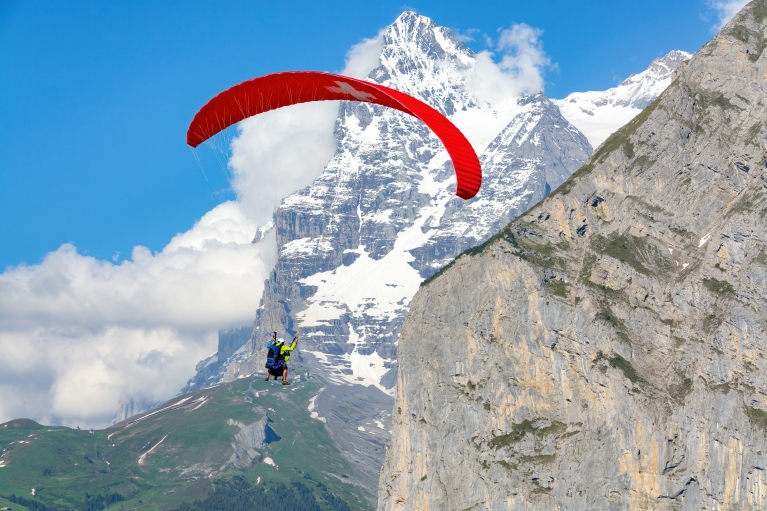
Paragliding past cliffs and waterfalls
Plenty of thrills can be experienced in the warmer months, too. Just ask my father, who soared off a mountainside with a glider on a warm May afternoon.
Mürren, a picturesque, car-less village perched above the Lauterbrunnen Valley, is a paragliding paradise, with multiple outfitters offering tandem flights near the town.
From Lauterbrunnen, Mürren can be reached by taking a panoramic cable car to the Grütschalp railway station and a breathtaking train ride on the Bergbahn Lauterbrunnen-Mürren (both are included in the Pass network). If the sky is clear, the region’s three famed mountains – the Eiger, the Mönch and the Jungfrau – can be seen, all in a row, from the train windows.
Paragliders take off from a steep alpine meadow just outside Mürren and cruise high above the valley floor, allowing travellers to take in the region’s dramatic crags and waterfalls from a perspective that few others experience.
“The view from up there,” my father said, reflecting on his paragliding experience, “I felt at peace. I felt free.”
Cycling down a mountain
There’s more than one way for adrenaline-seekers to travel from the heights of Mürren down to the lush Lauterbrunnen Valley.
On an early September visit to Mürren, my husband, brother-in-law, and I rented mountain bikes in the centre of town and cycled five kilometres past meadows and pastures, with the clanging of cowbells as our soundtrack. After reaching the Grütschalp railway station, we turned onto the steep and challenging Grütsch Trail.
Not for beginners, mountain bikers who take the Grütsch Trail experience a 600-metre change in altitude over the course of only 3 kilometres. I kept my eyes glued to the trail for the entirety of the ride, not daring to glance up to take in the forest views around me. Breathing a sigh of relief when we reached the relatively flat terrain of the Lauterbrunnen Valley, I felt a rush of gratitude for the nature around me – the mountains and meadows and the 72 waterfalls cascading into the valley. It’s said that Lauterbrunnen served as J.R.R. Tolkein’s inspiration for Rivendell, home of the elves in the Lord of the Rings series. When you’re standing in the centre of the valley, it’s easy to see why.
Fixing my gaze up to the peaks above me, I thought back to my first adventure in the Jungfrau region, sledging down Big Pintenfritz, and the enduring mystery of Fritz Bohren, the run’s namesake.
How on earth did Bohren manage to travel back to his sky-high hotel after sledging into the valley each night? Is it just a tall tale, exaggerated over the years, or is there some kernel of truth to the story?
This question is sure to enthral the new generation of travellers discovering the Jungfrau region’s magic. But as they have for decades past, the snow-capped mountains keep Bohren’s secret.
Feeling inspired? With Interrail and Eurail, you can:
-
Tour Europe by train with 1 Pass
-
Experience the highlights and hidden gems
-
Travel flexibly on trains that don't need reservations
-
Stay conscious and travel sustainably
Change of currency
You cannot change the currency once you have a Pass in your cart. Remove the Pass, and then change the currency on the website header.
